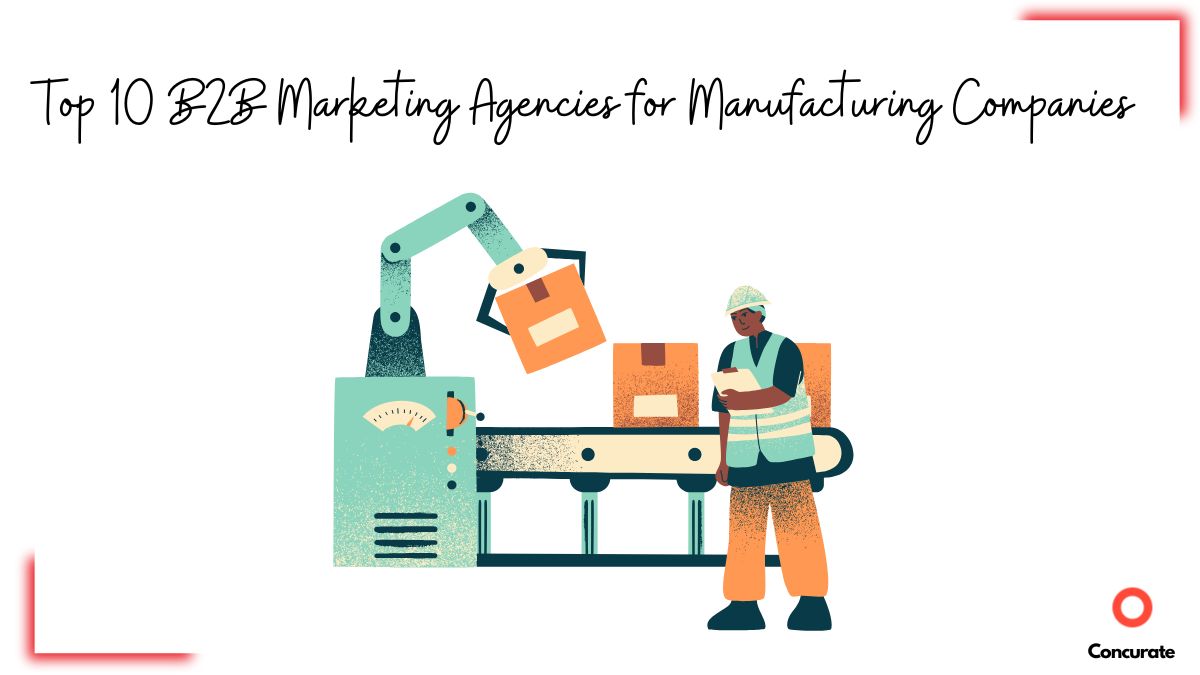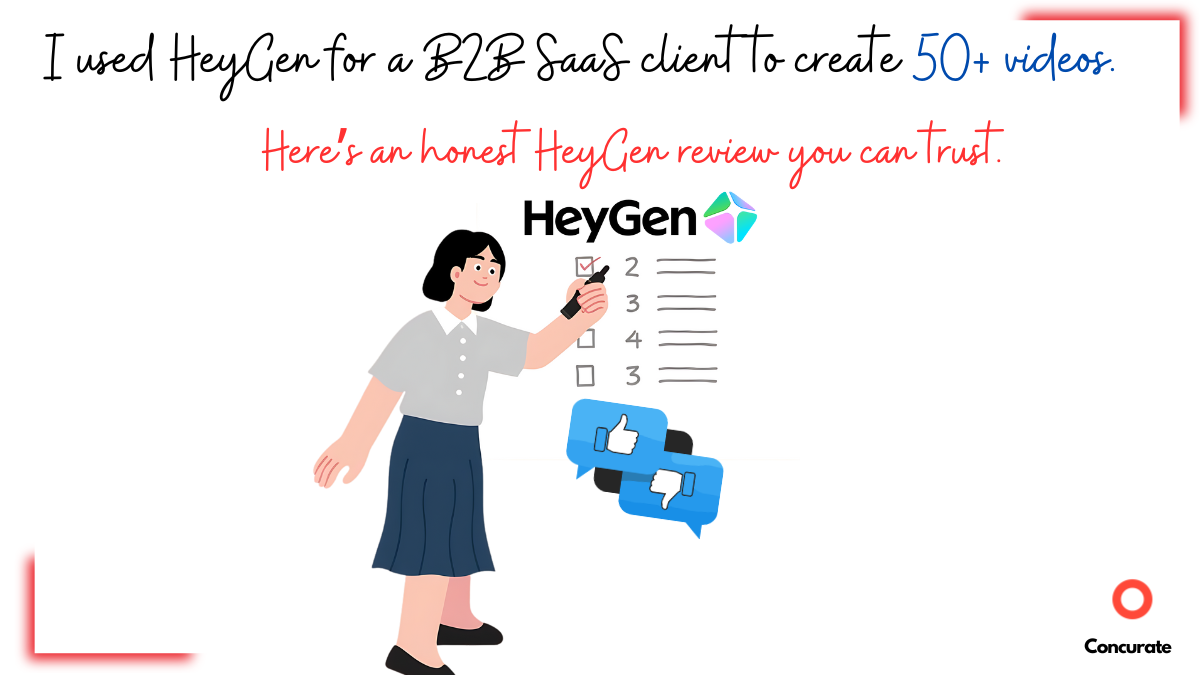| TL;DR – If your legal tech software is invisible to your ideal users, this guide breaks down six proven marketing strategies to fix that. From capturing high-intent buyers with pain-point content to scaling visibility through programmatic SEO and expert-led features. You’ll learn what actually works with real results from LegalTech brands we’ve helped at Concurate. |
Legal Tech Marketing that Build Trust and Generate Qualified Leads
You’ve built a solid product. Something that solves real problems. But right now, it’s like a rockstar playing to an empty room. No one’s paying attention.
At the same time, legal tech is booming. The market hit $29.8 billion, and it’s only growing.
That’s a big opportunity, but it also means more tools competing for the same buyer attention. Standing out takes more than a great feature set.
We’ve helped platforms like Triangle IP and IPToolWorks get noticed — not by shouting louder, but by using content strategies that build trust, attract high-intent traffic, and turn interest into demo requests.
In this article, we’ll walk you through six proven legaltech marketing strategies so the right users see your software.
Six Legal Tech Marketing Strategies That Attract the Right Users and Convert Them into Leads
What works for other SaaS products — in FinTech, MarTech, or HRTech — often falls flat in LegalTech. Why? Because your buyers think differently. They’re risk-averse, overloaded, and bound by strict compliance and legacy systems.
We’ve worked with LegalTech teams that have experienced the frustration firsthand. Over time, we’ve built strategies that address how legal professionals actually discover and trust new tools.
These aren’t generic playbook tactics. They’re hard-earned strategies; tested, refined, and proven to work.
Here’s a quick snapshot:
- Win Ready-to-Buy Users with Tool Comparison Content
- Answer What Your Buyers Are Searching Online
- Turn Product Data into Pages That Attract Visitors
- Offer Downloads Your Buyers Actually Want
- Build Trust That Converts with Proof Buyers Look For
- Get Featured Where Your Buyers Already Are
Now let’s unpack each one by one.
1. Win Ready-to-Buy Users with Tool Comparison Content
Many LegalTech founders, like most SaaS founders, approach content marketing by trying to rank for every keyword related to their space. That can help if your goal is to increase traffic.
But traffic alone doesn’t lead to signups, especially in legaltech marketing. Legal buyers are more cautious than most. They don’t buy software on impulse. They take their time, compare tools carefully, and evaluate every option before making a decision.
If your product doesn’t show up during that research phase, it’s likely to be overlooked — no matter how good it is.
That’s why the first marketing strategy we recommend is to focus on BoFu (Bottom-of-the-Funnel) keywords used by people already planning to buy.
| 📌 What Are Bottom-of-the-Funnel Keywords? Bottom-of-the-funnel keywords are search terms used by people who are almost ready to make a purchase. These users already understand their problem and know what kind of solution they need — now they’re comparing products and deciding which one to choose.These keywords often include phrases like:Best [tool category] for [specific task or role]Alternatives to [Competitor Name][Tool A] vs. [Tool B]Top [category] tools for [audience]Because these searches come from people close to buying, showing up for these keywords can directly lead to signups, demo bookings, or sales. |
Many companies that do target these decision-stage keywords often take a shortcut: they create short, templated landing pages just to rank on Google.
But that rarely works, especially for thoughtful, research-heavy buyers like legal professionals.
A simple comparison table or list of features isn’t enough. These readers want context, clarity, and confidence before they act. Short, rigid pages often leave too many questions unanswered.
That’s why we write in-depth, unbiased articles that walk the buyer through their options instead of quick templates. These pieces are long enough to cover the details, flexible enough to explain real use cases, and honest enough to earn trust.
We used this approach with Triangle IP. One of the articles we wrote — Top 5 Art Unit Predictor Tools — was aimed at patent professionals looking to improve prosecution workflows. It wasn’t just another SEO page — it was a helpful guide for patent professionals evaluating tools.
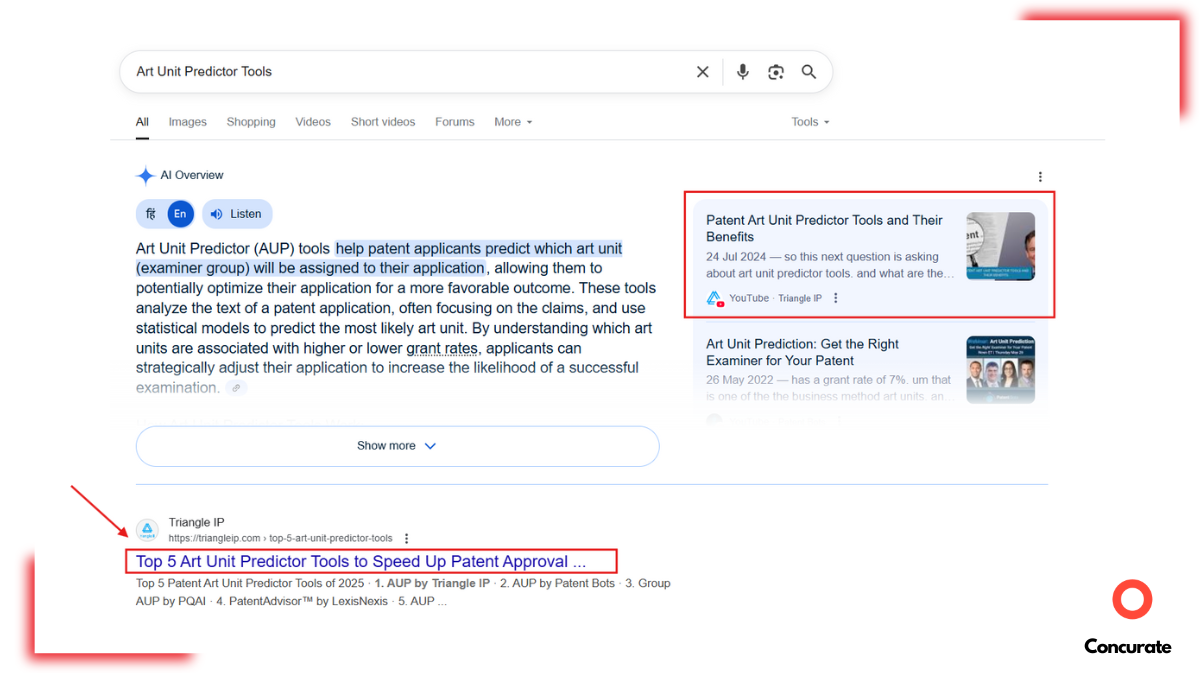
That one post now ranks at the top of search results, appears in AI overviews, and led to a measurable increase in signups.
2. Answer What Your Buyers Are Searching Online
Once you’ve covered the keywords used by people ready to buy, the next challenge is reaching buyers who don’t even know a solution like yours exists yet — but are actively looking for help with the problems your product solves.
Legal professionals often don’t search for a new tool directly. They search for ways to fix their day-to-day frustrations:
- How to speed up prior art search
- How to reduce office action drafting time
- How to avoid 101/103 rejections
These are long, specific queries that reflect real problems. And if your content answers them well — while naturally introducing your product — you build trust early in their journey.
But many SaaS companies skip this. Instead, they publish vague industry pieces like “The Future of IP Software,” which might sound visionary but don’t connect to buyers’ struggles.
That’s what our second legaltech marketing strategy is. Focus on writing content around pain-point-driven search queries. These are long, practical searches that legal professionals type into Google when they’re trying to solve something.
By creating in-depth, helpful articles that show how your tool solves that problem, you don’t just attract readers, you attract relevant readers. And when they see your product as the fix to something they already want solved, they’re far more likely to try it.
Note: Instead of starting with the product, we start with the problem and let the solution flow in naturally.
Again, take our work with Triangle IP. One of the blog posts we created was titled How to Reduce Your Outside Legal Services Fees. It spoke to a real pain point: IP teams spending hundreds of dollars just to get basic updates from their external counsel.
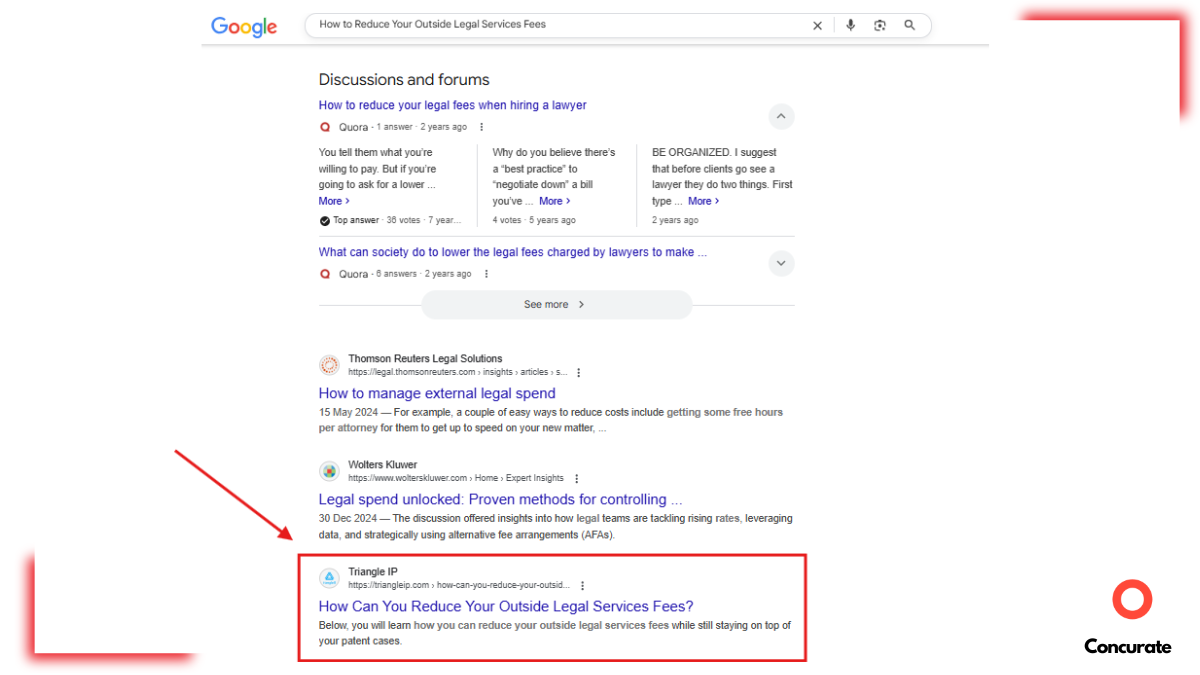
The article walked through that frustration and then introduced the TIP Tool™ as the fix. It explained how the product’s Portfolio Manager tab lets teams access timelines, costs, and patent family details — without always needing outside help.
Because the content started with the user’s problem and clearly showed how the product solved it, the article didn’t just bring in traffic; it also contributed to bringing in qualified leads.
Pro Tip: If you’re considering this strategy, you might also want to explore our guide on B2B SaaS Inbound Marketing Tactics That Work. It breaks down proven ways to attract high‑intent buyers, convert them with the right content, and nurture them into long‑term customers.
3. Turn Product Data into Pages That Attract Visitors
Many LegalTech platforms generate valuable data but keep it locked inside the product, visible only to existing users.
Think about examiner histories, office action trends, or common rejections by category. These are the kinds of insights patent attorneys search for every day. But if that information is buried inside dashboards and hidden behind logins, it never has a chance to attract new users.
That’s a missed opportunity to get discovered by the right audience.
Our next legaltech marketing strategy is all about unlocking this opportunity. Instead of creating many blogs from scratch, look at the structured data your tool already collects. Turn it into a series of helpful, search-friendly pages.
Here’s how:
- Start with a simple template (e.g., one per examiner)
- Fill it with useful, publicly searchable insights (recent cases, rejection breakdowns, success rates)
- Gate the deeper value (e.g., case numbers or response text) behind a signup or demo request
This approach lets your tool become a resource, not just a product. Each page works quietly in the background, attracting organic traffic from people searching for something your data already answers.
And the best part? Once you nail the format, you can create dozens or even hundreds of these pages without rewriting from scratch every time.
We used this approach, aka programmatic SEO, with IPToolworks through their “Know Your Examiner” campaign.
Patent attorneys often search for examiner-specific strategies, like “Examiner Arunava Chakravarti.” To match that intent, we helped IP Toolworks create dedicated pages for each USPTO examiner. Each page included:
- A snapshot of the examiner’s recent cases
- Argument outcomes across 101, 102, and 103 rejections
- A clear, no-fluff summary of trends attorneys could act on
The most valuable data, like case numbers and full office action responses, were gated behind a signup. And because the value was obvious, users didn’t hesitate to convert.
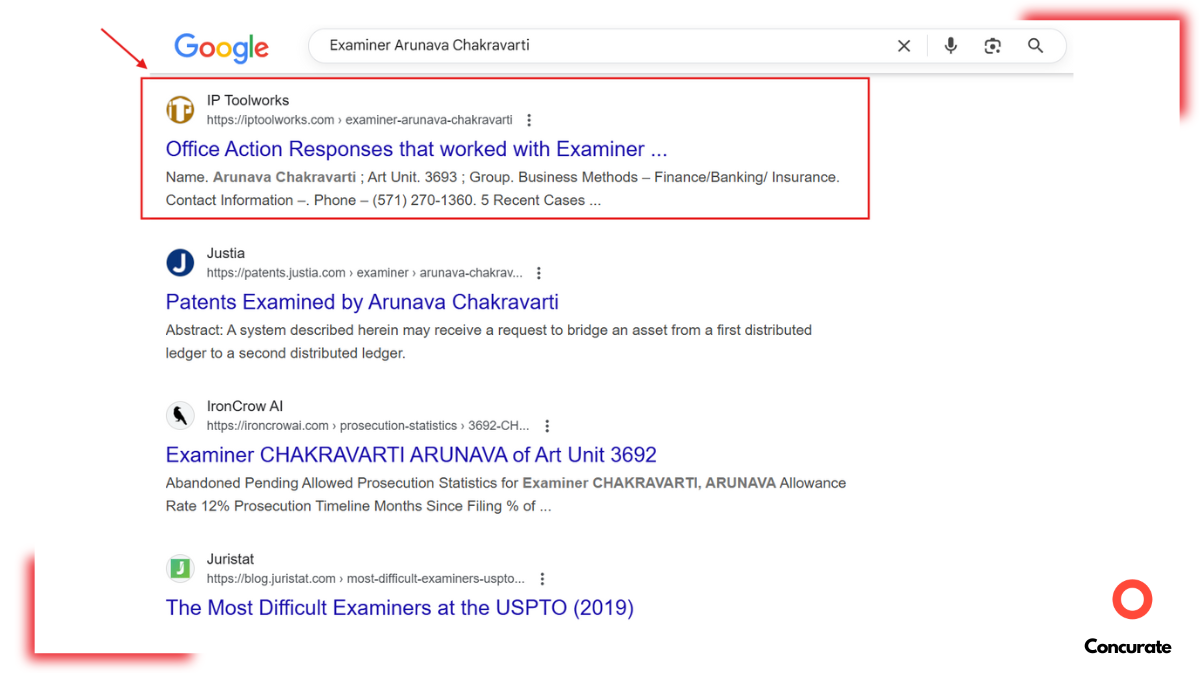
These pages now show up in search results for examiner names, drawing in attorneys at the exact moment they’re looking for insight. One glance shows them what they’re missing — and encourages them to sign up to see the rest.
The result? A scalable strategy that not only attracts qualified visitors but turns your product into a trusted reference point in the legal space.
📌 Interested in using programmatic SEO to scale your LegalTech visibility? Check out this case study on how we helped a network training provider dominate 60+ markets and attract a major enterprise lead.
4. Offer Downloads Your Buyers Actually Want
Most LegalTech sites have gated buttons: Sign Up, Request Demo, Contact Sales. That’s a big ask, especially for someone who just needs a simple fix. It’s no surprise they bounce. There’s nothing in it for them.
Instead of asking for something, offer something useful first. Think of it like a trade: “You give us your email, we give you a tool that makes your job easier.” No fluff, no filler. Just something practical they can use today.
Templates. Checklists. Worksheets. These don’t just improve UX—they build trust and give you a clear lead to nurture. That’s why they are called lead magnets.
That’s exactly what we did with Triangle IP. Innovation managers didn’t want to deal with long, complex invention disclosure forms (IDFs). So we gave them a solution: a simplified IDF template in Word and Excel.
We paired this lead magnet with SEO-optimized blogs like “Everything You Need to Know About Invention Disclosure Form When Aiming For High Value Patents,” added an easy download form (no sales pitch), and embedded it inside related content.

The result?
- Page views 6x’ed
- Leads doubled
- 25% of all new leads came straight from the IDF template (tracked in HubSpot)
And just like this one, we have many lead magnets in place for triangle IPs that are actually doing great for the website.
Bottom line: Solve a real problem, offer real value, and you won’t need to chase leads—they’ll come to you.
For more such hacks, check out B2B SaaS Growth Hacks.
And, to get a curated list of 30 standout SaaS growth hacks to double the growth for your SaaS business, fill out the form below!
5. Build Trust That Converts with Proof Buyers Actually Look For
Writing a great blog is just the start. In a niche like LegalTech, organic traffic takes time to pick up, so your content needs to keep working for you.
At Concurate, we start with EEAT principles, so both Google and your readers see your content as credible.
| 📌What are EEAT principles? EEAT stands for Experience, Expertise, Authoritativeness, and Trustworthiness.Experience is about showing you’ve been there or done that. For example, a patent attorney sharing how they handle office action responses shows real-world experience.Expertise means you know your stuff. If your blog is written by someone who understands LegalTech deeply, Google will consider it more credible.Authoritativeness is about your reputation. When other trusted sites link to you or mention your content, it signals that your insights carry weight.Trustworthiness is the foundation. Clear sources, accurate claims, secure sites, and transparent authors make Google and your readers feel safe relying on your content. |
But EEAT doesn’t stop at the blog. Legal buyers rarely try a new tool unless they feel it’s safe and reliable.
That’s why your site should also highlight real trust signals:
- Verified user reviews on platforms like G2 or Capterra
- Security certifications and badges
- Transparent policies around data privacy
Like those displayed by InspireIP and DeepIP, it instantly reassures visitors that their information is in safe hands.
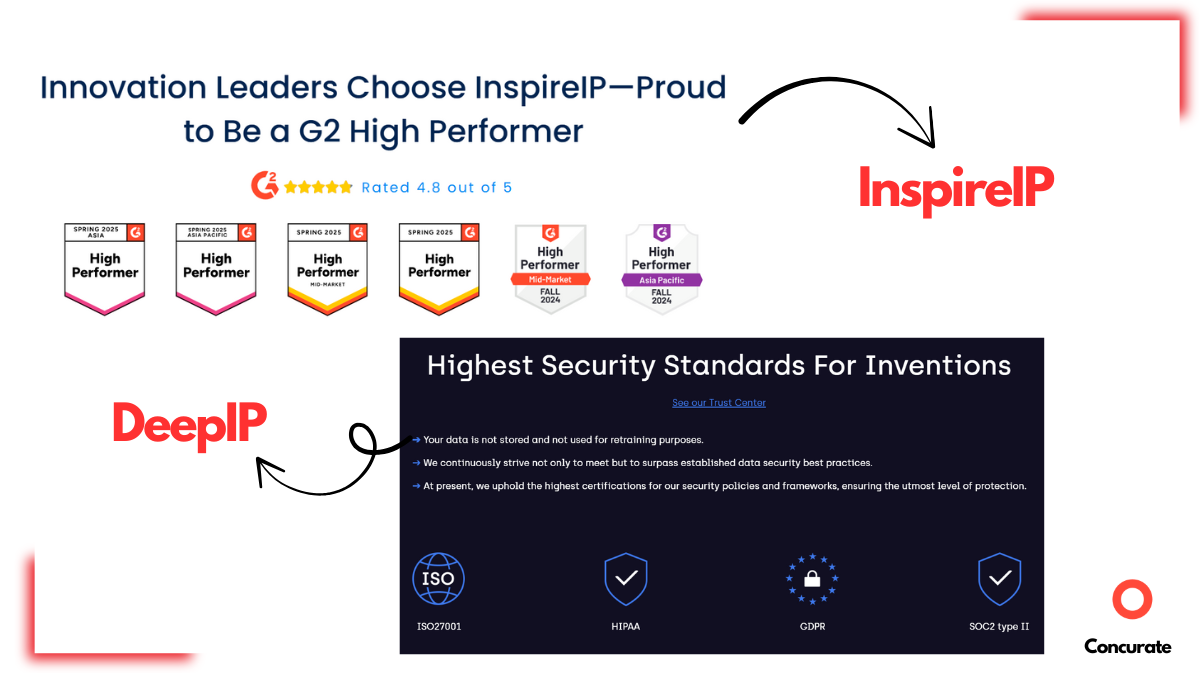
Recommended Read: LexisNexis SEO Analysis: Inside the Playbook Powering 59,000+ Keywords
6. Get Featured Where Your Buyers Already Are
Great content on your site is only half the job. If you want decision-makers in legaltech to actually see it, you need to appear in the places they already read and trust.
Legaltech buyers don’t hang out on generic marketing blogs. They spend time on niche publications like IPWatchDog, World IP Review, Managing IP, or even Entrepreneur, depending on their role. If your brand never shows up there, you’re invisible to those who matter.
Here is what you need to do. Once you have a few strong content pieces and expert POVs, distribute that credibility by:
- Publishing guest posts on IP and legaltech-specific media
- Pitching your founder’s story or product POV to relevant platforms
- Securing expert mentions in roundup articles, LinkedIn posts, or niche newsletters
This builds awareness, credibility, and drives referral traffic — all without relying solely on SEO.
We followed this exact play with Triangle IP. Their founder, Thomas Franklin, contributed expert articles to IPWatchDog and Entrepreneur, sharing actionable insights from his experience in IP law and innovation management. As part of the contributor guidelines, he was allowed to include one backlink — which we used strategically to point to a high-value blog post on the Triangle IP website. This earned powerful backlinks and sent steady, qualified traffic from readers who were already primed to engage.
The result? TIP Tool™ gained authority and visibility in front of the right audience, while Thomas was positioned as a credible voice in the legaltech space. This strategy even helped revive a long-buried blog post — lifting it from Page 7 of Google all the way to Page 1. You should check out the full case study to see exactly how we did it.
For more practical tips and examples, check out our blog, The secret formula for Crafting Engaging Content—it’s packed with insights to strengthen your content strategy.
Mastering these six strategies can turn your LegalTech tool from hidden in plain sight into the solution your ideal buyers are actively chasing. But great strategy needs precise execution — and that’s where most legal tech marketing efforts fall short. You need a partner who knows how to turn niche expertise into real pipeline growth. That’s why Concurate isn’t just another agency. It’s the strategic advantage. Let’s see why.

Must Read: Content Marketing Agency vs. Freelancer: Who to Choose for Generating Leads for Your IP Software
Concurate: Your Reliable Legal Tech Marketing Partner
We’ve helped LegalTech SaaS products go from best-kept secret to must-try solution. The content we create doesn’t just sit on a blog—it builds trust, pulls in the right buyers, and turns passive readers into demo-ready leads.
And we don’t stop at publishing. We measure, tweak, and double down on what works. One Triangle IP blog, once buried on page seven of Google, now ranks in the top three, appears in AI overviews on ChatGPT and Perplexity, and continues to bring in qualified leads—week after week.
Don’t take our word for it. Hear what Thomas Franklin, Founder of Triangle IP, says about working with Concurate.
Your product could be next. Are you ready to make it the solution everyone in legal talks about? Let’s make it happen.
Book a strategy call with Concurate and watch your content start driving growth around the clock.
Questions on Your Mind? We’ve Got Answers
1. How Can I Boost The Visibility Of My LegalTech Software In ChatGPT Searches?
You can increase visibility by following these:
- Create an LLMs.txt file—a simple, markdown‑style file that lists your high‑value pages (like product guides, case studies, and blogs) with short summaries.
- Prioritize quality content: Highlight pages that demonstrate expertise, solve problems, or help convert users.
- Keep it organized: Group URLs into clear sections like Product, Docs, Blog, or Case Studies to help AI interpret your site.
- Use concise, human‑friendly descriptions: 1–2 sentences that explain what each page is about.
- Update regularly: Refresh your LLMs.txt file after major content updates or at least once a quarter.
- Earn mentions and citations: Guest posts, directories, or high‑authority mentions increase the chance AI tools surface your brand.
Read the article on how to optimize a website for AI search engines.
2. What’s The Minimum Time For Legaltech Content Marketing To Show Results?
Content marketing for LegalTech or SaaS products usually takes 2–3 months to show early results, such as initial traffic and keyword rankings. Achieving consistent lead generation and high‑intent organic traffic typically takes 6–12 months, as SEO and authority build over time.
See this SaaS SEO case study for a real example.
3. How Can I Evaluate A Content Marketing Agency To Market My Legal Tech Software?
Look for an agency with LegalTech or B2B SaaS expertise, a conversion-focused strategy, and proven case studies showing real signups or demo requests. Ensure they offer transparent processes and content distribution across SEO, LinkedIn, and guest placements to reach decision-makers effectively.
Check out the content marketing agencies for B2B Legal Tech companies.
4. How Do Legal Tech Companies Build High-Authority Backlinks?
The best legal tech companies get backlinks via strategic partnerships. For example, Smokeball grew to DR 70 by securing 95+ backlinks from state bar associations. Not through outreach emails or guest posts, but by turning a freemium product into a member benefit that bar associations actually wanted to promote.
Read our complete Smokeball backlink analysis to see the exact playbook they used.



